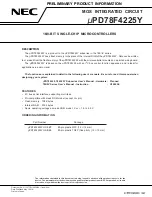
11
8.8.
If the motor continues to hum or buzz after the
OUTPUT VOLTAGE RANGE switch is turned off, the
solid-state switch controlling the motor may be
defective. De-energize the input line to the voltage
regulator, and replace the control board.
8.9.
If the motor has driven to one end or does not
drive at all, check to ensure the motor drive is
functioning correctly. Refer to the unit's schematic
diagram to complete the following steps:
De-energize the input line to the voltage regulator;
place the OUTPUT VOLTAGE RANGE switch in the
center (off) position, and remove POWER fuses F1 and
F2 on each control module.
Apply 115 volts AC between terminals A1-TB1-1 and
A1-TB1-2 on the control module, or to the
corresponding terminals at the motor board terminal
strip (TB1). These nine junction terminal strips are
connected point-for-point. The motor should turn the
variable transformer counter clockwise (viewed from
top) so as to lower the output voltage until it reaches
the end of its travel, where the limit switch will prevent
further rotation in that direction.
Apply 115 volts between terminals A1-TB1-1 and
A1-TB1-3 should run the motor in the opposite direction
until a limit switch stops the motor at the end of travel.
If the motor operates successfully in this test the
problem may be with the control board.
8.10.
Inspect the POWERSTAT Variable Transformer
brush(s) and commutator(s) for signs of wear or
damage. The brush assemblies on the variable
transformer section will not need replacement under
normal conditions. When excessive brush wear or
commutator damage occurs, it is usually the result of
an
overload.
If
either
condition
exists,
the
POWERSTAT Variable Transformer section or the
brush must be replaced or repaired. Check the load to
be sure the output current rating of the voltage
regulator is not being exceeded.
Do not attempt to clean a commutator with an
abrasive such as sandpaper or a file.
This will ruin
the soft precious metal plating on the commutator
surface and will shorten the life of the unit. It is normal
for commutators to become black due to carbon brush
tracking. If a commutator is to be cleaned, use
denatured alcohol and a soft cloth.
8.11.
Check the variable transformer radiator(s) (the
die cast part that holds the brush assembly) for signs of
slippage, and see if all brushes driven by the same
motor are aligned with each other. The alignment of the
radiator and brushes depends on the setscrews that
hold the variable transformer center tube(s) to the shaft
and the setscrews that hold the radiator to the center
tube. Adjust and tighten as needed.
Содержание STABILINE WHR34 T Series
Страница 2: ...2 ...
Страница 16: ...16 11 0 SCHEMATIC For reference only use full size supplied with unit ...
Страница 17: ...17 12 0 FLOOR MOUNT DIMENSIONS Enclosures A through G Note All dimensions are inches millimeters ...
Страница 18: ...18 Enclosures A through G continues Note All dimensions are inches millimeters ...
Страница 19: ...19 Enclosures A through G continues Note All dimensions are inches millimeters ...
Страница 20: ...20 Enclosures DPLUS through GPLUS Note All dimensions are inches millimeters ...
Страница 21: ...21 Enclosures DPLUS through GPLUS continues Note All dimensions are inches millimeters ...
Страница 22: ...22 Enclosures DD through GG Note All dimensions are inches millimeters ...
Страница 23: ...23 Enclosures DD through GG continues Note All dimensions are inches millimeters ...
Страница 24: ...24 Enclosures EEE through GGG Note All dimensions are inches millimeters ...
Страница 25: ...25 Enclosures EEE through GGG continues Note All dimensions are inches millimeters ...












































